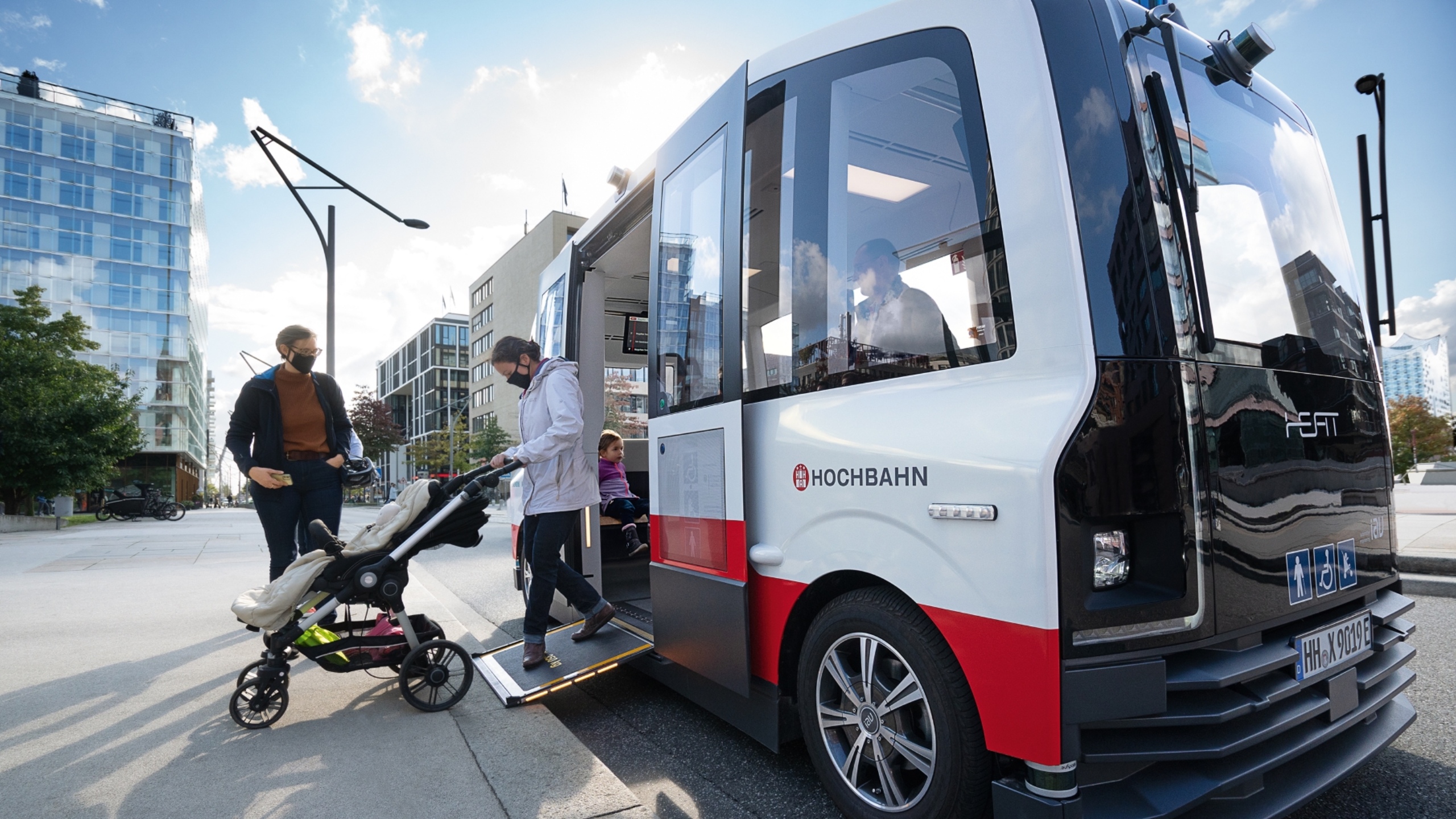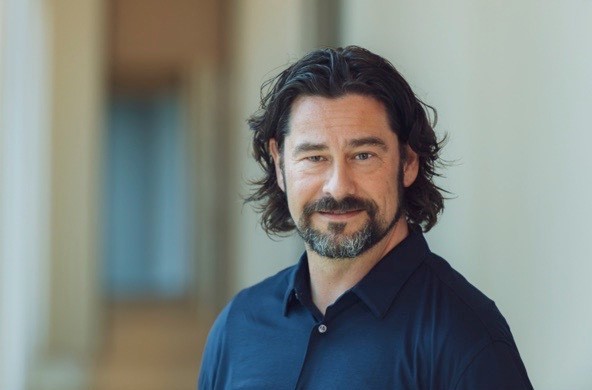HEAT begins passenger operation
24.10.2020 —
Berlin. The Senator for Transport and Mobility Turnaround, Dr. Anjes Tjarks, takes his first ride in the autonomous minibus. The approval has been granted for passenger rides with a vehicle attendant. Residents of Hamburg can experience HEAT for themselves.

We did it! Despite the challenging conditions resulting from the corona pandemic, today the research and development project HEAT (Hamburg Electric Autonomous Transportation) is reaching its next and perhaps biggest milestone. Senator for Transport and Mobility Turnaround, Dr. Anjes Tjarks, and HOCHBAHN CEO, Henrik Falk, launched the public test run with passengers today and were the first on board the five-meter-long autonomous minibus. The project is part of the ITS (Intelligent Transport Systems) strategy by the Free and Hanseatic City and will be presented at next year’s ITS World Congress in Hamburg.
Dr. Anjes Tjarks, Senator for Mobility Turnaround: “A short distance for the bus – but a real milestone for the mobility of tomorrow. With passenger service starting, HEAT will become part of the smart mobility mix in our city. The project shows how modern mobility is imagined in Hamburg and especially at HOCHBAHN. Putting autonomous driving into practice in the midst of an urban environment with cyclists and pedestrians is challenging and, in this form, unique in the world. It is a great accomplishment, but also an important contribution to shaping mobility of the future. What I find really fantastic is that autonomous driving can now be experienced by the people of Hamburg, too, thanks to the launch of the passenger service. We want to be at the world’s forefront of autonomous driving by the time the ITS World Congress is held.”
The autonomous minibus travels through HafenCity at speeds of up to 25 km/h. In addition to having its own system for sensing the environment, the shuttle uses two other sources of information while traveling the approximately one-kilometer-long test route: Firstly, it accesses the innovative roadside infrastructure developed by Siemens Mobility and integrated by Hamburg Verkehrsanlagen (HHVA). The use of additional masts with sensors along the route is unique in this form; it expands the shuttle’s field of vision and thereby enables higher speeds and predictive driving. Secondly, the vehicle uses the HD map of the current route provided by the Free and Hanseatic City of Hamburg, which is accurate to within a few centimeters. All of the information from these sources is superimposed while driving to precisely identify the position of the vehicle and deviations from the optimal position.
The research project has now received the necessary approval to operate with passengers. Now, for the first time in Germany, an autonomous minibus is allowed to operate in public downtown streets with passengers at speeds of up to 25 km/h. Starting now until the end of November initially, Hamburg’s citizens can experience HEAT for themselves. They can book rides for the autonomous shuttle via app. A mask covering the nose and mouth is required in compliance with corona regulations. Due to infection prevention measures resulting from the pandemic, the shuttle can carry up to three passengers at a time in addition to the vehicle attendant and a technical support specialist. Despite these challenges, the project consortium decided to launch passenger operations after receiving approval.
Henrik Falk, CEO of HOCHBAHN: “We are very proud of this great leap forward. Bitkom recently selected Hamburg as Germany’s smartest city in terms of mobility – and HEAT’s connected approach matches this perfectly. Now that we can put the shuttle into operation, we are getting much closer to the concept of the research project: to provide an autonomous minibus as a new service when it is not practical to use larger vehicles – such as during odd hours or on the outskirts of the city. The research conducted could make it a reality. Of course, we know there is still a long way to go – but we are making progress.”

In the current project phase, the vehicle receives the driving task, including the stops to make, from the HOCHBAHN control center. The control center monitors operations and can give the vehicle appropriate commands depending on the current traffic situation. In addition, one of four specially trained HOCHBAHN vehicle attendants as well as a technical support specialist will always be on board. For passenger operation, the autonomous shuttle bus is also equipped with an information system for passengers which displays the upcoming stops and their arrival times on two monitors.
Matthias Kratzsch, Managing Director Technology at IAV: “As those responsible for overall vehicle development and for the autonomous driving technologies integrated in the shuttle, we engineers are now starting what is likely the most exciting project phase: After intensive testing and fine-tuning between the shuttle and roadside infrastructure, passengers can finally experience the electric minibus and thus autonomous driving for themselves. We are looking forward to feedback from passengers, which will help us further optimize the shuttle for presenting at ITS next year.”
One special feature of the HEAT project compared to other autonomously driving vehicles is the roadside infrastructure. It provides additional data about what is happening on the road and reports it to the shuttle – including information about vehicles, cyclists or pedestrians who are outside the field of vision of its sensors. This is particularly relevant, for example, if there are objects located in an intersection that cannot be seen or are obscured by a larger vehicle. In addition, this communication enables traffic lights to be passed without the vehicle attendant taking action.
Manfred Fuhg, German Head of Intelligent Traffic Systems, Siemens Mobility: “Together with Hochbahn and all of its partners, we are shaping the future of mobility in Hamburg with a pioneering spirit. Today we reached a milestone: the start of autonomous and safe shuttle operation with passengers in road traffic. We are pleased to be part of the pioneering HEAT project.”
With the launch of passenger operations, DLR’s accompanying research is also entering the next and decisive phase. For the first time, passengers can be interviewed directly in response to their riding experience. In addition to the passenger experience, DLR will also examine how the use of self-driving vehicles in public transport impacts activities for the operator, for example, due to new requirements for work in the control center.
Prof. Dr.-Ing. Katharina Seifert, Institute Director DLR, Institute of Transport Systems Technology: “User requirements for mobility solutions of the future are a main theme of our research. The test operation with HEAT provides a great opportunity to identify the needs and perceptions of the people using the shuttle. Analyzing actual passenger perceptions allows us to specify the requirements for the technology and design of the service in order to optimize the user experience.”
One of the biggest challenges in the research project remains the legal framework for driving without a vehicle attendant according to SAE Level 4. Autonomous driving is not yet covered by the current legal framework. The processes surrounding approval procedures are likewise extensive and depend largely on regulatory requirements.
Matthias Hartwig, IKEM: “Within the current legal framework, approval of the HEAT shuttle for passenger transport is a major accomplishment that could only be achieved thanks to excellent cooperation with the Hamburg authorities. The next step will now be to test higher automation levels. This requires an experimental clause in the Road Traffic Act that allows driving without a vehicle attendant and thereby advancing the technical development.”
Test operation with passengers will start in HafenCity on October 23 and will initially run until November 30. Hamburg residents who are interested can find out about current operating hours at www.hochbahn.de/heat. The HEAT app, which offers users free registration for rides, can also be downloaded there.
It is hardly a coincidence that the autonomous HEAT minibus is completing its test drives in the HafenCity: The pioneering spirit of HafenCity has long included mobility. In the eastern districts of Baakenhafen and Elbbrücken, new standards are being set with a Europe-wide innovative Smart Mobility concept that promotes e-mobility and car sharing and begins right from the private underground garage. HafenCity is already very well connected by public transport. In addition to S-Bahn, metro and bus services, there are numerous other mobility options with StadtRAD, Bike & Ride and hvv switch points.
After completion of the test operation with passengers, the vehicle will return to Gifhorn for evaluation and further development before it goes back to Hamburg for the next phase of the research project with passenger service in spring 2021.
Project partners
Hamburger Hochbahn AG
Founded in 1911, Hamburger Hochbahn AG carries over 1.2 million passengers daily with its fleet of 250 metro trains and 1,000 buses. As one of 34 partners in the Hamburger Verkehrsverbund (HVV), HOCHBAHN serves over 1,400 stops in the city and is the largest transport company in the HVV. Around 6,000 employees work for HOCHBAHN around the clock to provide attractive public transport and convenient, highly modern mobility in Hamburg.
Authority for Transport and Mobility Turnaround
The BVM is one of eleven specialized authorities of the Free and Hanseatic City of Hamburg and is responsible for economic and transport policy as well as for promoting innovation. To implement the HEAT project, the BVM is drawing on the competencies of the Department of Home Affairs and Sport, the Police Traffic Directorate, the Department of Traffic (LBV), the Department of Roads, Bridges and Water (LSBG) and the municipal Hamburg Verkehrsanlagen (HHVA). Within the project, the LSBG is responsible for traffic planning, while HHVA implements and operates the roadside infrastructure.
IAV
With more than 8,000 employees, the IAV is one of the world’s leading engineering partners to the automotive industry. The company has been developing innovative concepts and technologies for future vehicles for 35 years and achieved sales of more than 1 billion euros in 2019. Its customers include all major automobile manufacturers and suppliers worldwide. In addition to vehicle and drive development, IAV entered the field of electromobility and autonomous driving at an early stage and is now one of the leading development service providers in these fields. Along with its development centers in Berlin, Gifhorn and Chemnitz/Stollberg, IAV has locations in Munich, Sindelfingen and Ingolstadt as well as in Europe, Asia and in North and South America.
Siemens Mobility GmbH
Siemens Mobility is a separately managed company of Siemens AG. As a leader in transport solutions for more than 160 years, Siemens Mobility is constantly innovating its portfolio in its core areas of rolling stock, rail automation and electrification, turnkey systems, intelligent traffic systems as well as related services. With digitalization, Siemens Mobility is enabling mobility operators worldwide to make infrastructure intelligent, increase value sustainably over the entire lifecycle, enhance passenger experience and guarantee availability.
IKEM
IKEM – the Institute for Climate Protection, Energy and Mobility – is an independent research institute that addresses current climate protection, energy and mobility transformation issues. One of the institute’s focal points is autonomous driving: Among other things, IKEM is responsible for the legal support of test operations and evaluating business and operator models for autonomous shuttles.
DLR
The German Aerospace Center e.V. (DLR) is operated by the federal government. It also conducts research and development work in the fields of energy, transport, security and digitalization. In the HEAT project, DLR researchers are investigating the needs and responses of users and other road users related to autonomous buses.
Contacts for the media
Hamburger Hochbahn AG
Constanze Dinse – presse@hochbahn.de – 040 3288 4386
Authority for Transport and Mobility Turnaround
Dennis Krämer – dennis.kraemer@bvm.hamburg.de – 040 428 41 1685
IAV
Kevin Schrein – kevin.schrein@iav.de – 0172 190 1432
Siemens Mobility GmbH
Eva Haupenthal – eva.haupenthal@siemens.com – 0152 01654597
IKEM
Dennis Nill – dennis.nill@ikem.de – 030 408 1870 17
DLR
Jasmin Begli – jasmin.begli@dlr.de – 0172 2753385



